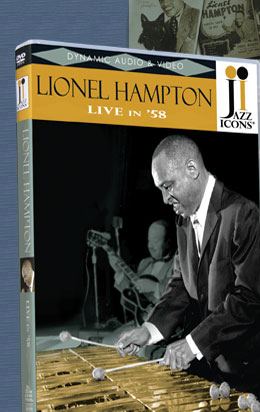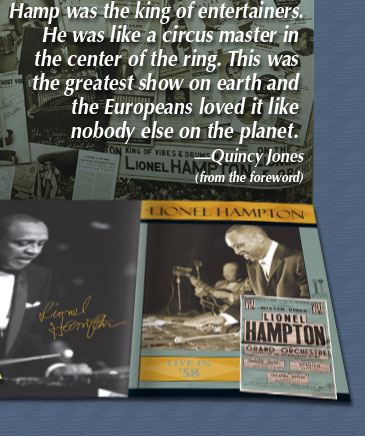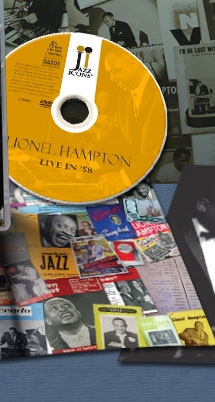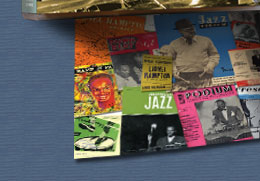




 |
 |
|
|||
|
|
|
||||
|
|
|
||||
|
|
|
||||
|
|
|
||||
 |
|
||||
 |
|
||||
 |
|
||||
|
|
|
|
|
|
|
Jazz Icons: Lionel Hampton spotlights a fiery hour-long concert from one of the most beloved bandleaders in jazz history. Hamp, the irrepressible king of entertainers, plays vibes, drums, piano, and sings and dances as he and his legendary big band absolutely delight this Belgian audience. |
|
 |
|
|
|
|
|
|
Sample of Foreword: This is the Lionel Hampton I still remember so clearly. When he hit that stage there was only one thing that mattered and that was making sure that crowd had the time of their lives. The band on this DVD is red hot. My old friend Bobby Plater, who first introduced me to Gates in 1949, is still blowing hard. (Hamp called everybody Gates and everybody called him Gates. It was a habit he picked up from Benny Goodman and it was easier than remembering names.) Billy Mackel and Eddie Mullens are still there, as well as a whole new group of hard-honkin’ young bucks. Hamp was the king of entertainers. He was like a circus master in the center of the ring with lions jumping through burning hoops and acrobats balancing on wild horses. This was the greatest show on earth and the Europeans loved it like nobody else on the planet. But it wasn’t just a wild show; these cats were musicians of the highest order. Hamp only hired the best. ... —Quincy Jones
Sample Liner Notes by John McDonough: Lionel Hampton’s New World Of Jazz The concert on this DVD, filmed by Belgian public television on Feb. 17, 1958, was substantially the same Lionel Hampton Orchestra I saw at the tender age of 16. It was Wednesday morning, I think, July 30, 1958, when the phone rang and Bob Spindell, a classmate of mine since second grade, invited me to go with him and his parents to see Lionel Hampton that night at Ravinia Park, the outdoor summer home of the Chicago Symphony Orchestra. When I received the rough edit of this DVD after the request for annotation, it landed like a recovered memory, formative in its time and transportive today as I recalled the Hampton I had first experienced in 1958. ... To have seen Hampton in 1958 was to have seen him at the peak of his powers. Saxophonist Bobby Plater had been with the band since 1945; trumpeter Ed Mullens, since 1949. And, of course, guitarist Billy Mackel would know virtually no other life, having started in 1944 and staying until his retirement in the late 1970s. Many of the others were brilliant, young, ex-servicemen Hampton had recruited from Army bases on earlier European tours. The concert I saw at Ravinia offered a mix of often-sophisticated charts one moment, and the sight of Hampton leaping up on his tom-tom the next, jumping up and down and exhorting the band to greater heights of ballyhoo. And if that wasn’t enough to get the crowd riled up, he raised the stakes by leading the band Pied Piper-like into the audience and marching up and down the aisles. (When the band played Basin Street in New York, it would often—weather permitting—march upstairs and out onto Broadway and 51st Street, confounding traffic, passersby and police.) The audience loved it. It was a “show band,” after all. “It was really a fun band,” Hoyle says. “A lot of fine musicians. I learned a lot, too. He wanted me to be a brass section leader and lead the rehearsals, and I ended up splitting the lead with Dave Gonzalez and the jazz with Eddie Williams. I learned about the machinations of a big band and how to cope with all the different living conditions on the road. Even things like microphone technique when I soloed.” In many ways, we are lucky that the concert on this DVD preserves far more fine jazz than rabble-rousing showmanship. Though his tom-tom remains little more than a stage prop here (although Hampton could be a serious, powerful and propulsive drummer behind a big band; listen to “Smoke House Rhythm” with Goodman in 1938), at least he uses it as a drum and not a pedestal. Although no concert was complete without “Flying Home,” if it was played here, it was not filmed. The pieces are mostly simple ensemble riffs and improvisations on the blues, essentially jams that Hampton was free to name as he pleased, often with local interest in mind such as “Brussels Sprouts.” ...
All words and artwork on this page ©Reelin' In The Years Productions. Unauthorized use is prohibited.
|
|
Site contents ©Copyright 2008 Reelin' In The Years Productions
Site designed by Tom Gulotta